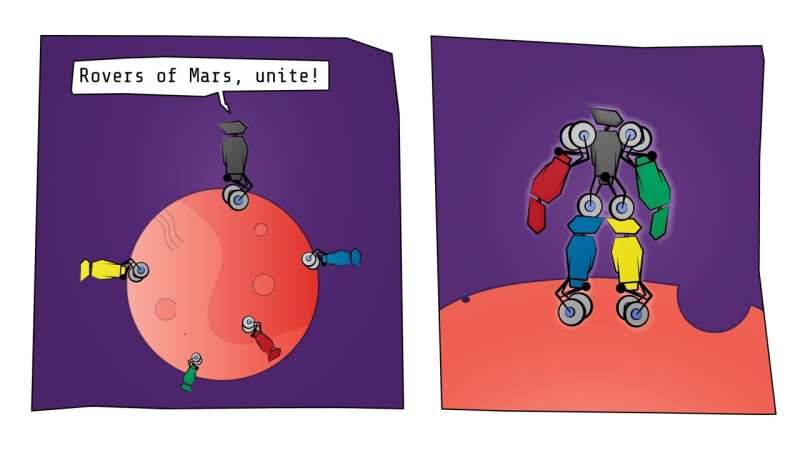Divide and conquer: Mars rovers could be superseded by swarms of two-wheeled robots

Skoltech scientists have proposed a concept for a modular Mars exploration rover. Leveraging the power of cooperative robotics, the new system first described in an Acta Astronautica paper consists of four two-wheeled robots that can operate independently or combine in various constellations. According to the study, that approach will enable longer exploration missions that gather more information about the planet’s history, potential habitability, and possible traces of surface water or prior life.
Since NASA’s Pathfinder, the first successful Mars rover, landed on the Red Planet in 1997, researchers have used the same basic design: a six-wheeled autonomous exploratory vehicle carrying a set of scientific instruments on board. Nowadays, researchers suggest that a Mars mission could accomplish more in the same timespan if it consists of several variously equipped robots simultaneously carrying out separate tasks at different locations and occasionally coming together for more challenging tasks.
“This is basically an optimization problem: How do you maximize exploration time and distance covered without driving the cost of the mission through the roof?” Skoltech Ph.D. student and the study’s first author Alexander Petrovsky commented. “We found that using one six-wheeled rover can be suboptimal. According to our calculations, four two-wheeled machines are the best way to go. Each would carry unique research tools with only the critical payload present in all four modules.”
That way, even when three of the four robots fail, the remaining one can still do a fair amount of work and transmit its findings to Earth. This maximizes the ultimate results of the mission by the time it terminates. When performing operations that require maximum stability—such as grabbing things—a pair of rovers with two wheels could assemble into a four-wheeler to be on the safe side and avoid falling over.
“Basically, reduced stability is the main drawback, with all the other parameters we considered looking reasonably good or better for the swarm rover scenario,” Petrovsky added. “That said, two-wheeled robot technology has come a long way toward making those things more stable than they used to be, so even that is somewhat less of an issue now.”
The scientist continued, “Artificial intelligence technologies supervising the swarm of mobile robots will open the doors to a new technological level of planetary exploration.” According to him, swarm robot technology intended for Mars exploration could also benefit lunar missions and even projects on Earth. For example, similar two-wheeled robots could be deployed to monitor the growth of agricultural plants and detect pests or diseases affecting them. “In July 2021, we did some field tests with small two-wheeled robots on crops in Krasnodar, Russia,” Petrovsky said. Besides this, the modular approach could also benefit robotics developed for search and rescue operations.
Alexander Petrovsky et al, The two-wheeled robotic swarm concept for Mars exploration, Acta Astronautica (2022). DOI: 10.1016/j.actaastro.2022.01.025
Citation:
Divide and conquer: Mars rovers could be superseded by swarms of two-wheeled robots (2022, April 14)
retrieved 14 April 2022
from https://phys.org/news/2022-04-conquer-mars-rovers-superseded-swarms.html
This document is subject to copyright. Apart from any fair dealing for the purpose of private study or research, no
part may be reproduced without the written permission. The content is provided for information purposes only.
For all the latest Science News Click Here
For the latest news and updates, follow us on Google News.

